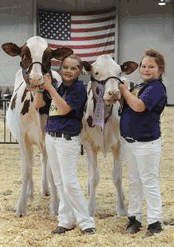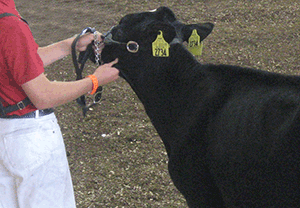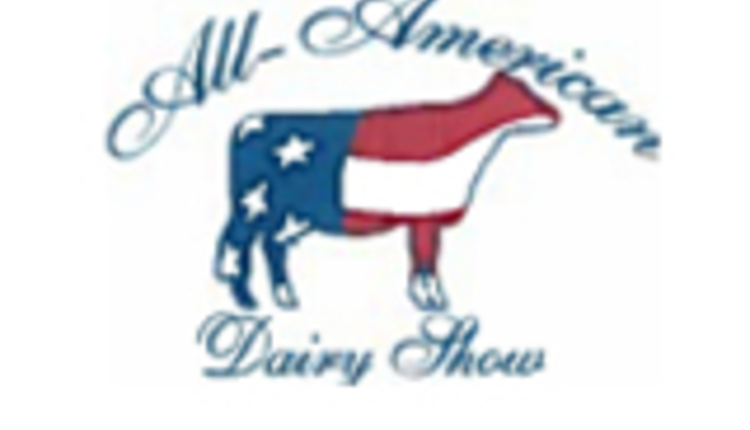
I attend several youth dairy shows throughout the year as a spectator, but participated in dozens during my junior years. Showmanship is the chance for all junior exhibitors to showcase their animal preparation and handling skills. From the stands, I can spot things that those working closely with the animals may have overlooked. I wonder, did the youth participant simply forget or unknowingly missed the task? I want them to be prepared so they can have a positive experience rather than walking out of the ring disappointed with a laundry list of things they did wrong.
As many young people are working with their animals for spring shows and fairs, many focus on getting the animal to lead well and practice sculpting the perfect topline. While those are two important components, there are a few smaller items that might just be the difference in making a junior fully prepared to compete.

Does your halter fit? With the new showmanship rules established in 2011, a correct fitting halter is part of the scorecard. (Click to see a previous blog on the showmanship changes.) The halter is key in managing your animal's movements. If it is positioned too far down the nose or fitted too tight, the chain will not be placed under the animal's chin in the correct location. And when it does not sit comfortably on your animal, she may act up because the halter is uncomfortable. If you are showing a young calf, be sure to find a halter that fits a smaller head so she responds to your directions.
Clean ears. While not an obvious thing to notice, your animal's ears should be clean. This includes the visible part where the ear tag may be positioned, but also inside the ear. Keep cleaning the ears until the towel comes out clean. Initially your animal may toss her head, but ears should not be cleaned for the first time two minutes before you walk into the ring. Doing a thorough job at home will make it easier for you to clean them on show day.
Clean eyes. Moisture can dry around eyes and form crusty discharge. Your heifer should look alert and you do not want gunk to distract from her appearance. Summer heat and flies can make the situation more likely to occur.
Reclip. While you are still focusing on the animal's head, has the animal's head been clipped recently? Some fairs may be close to each other, but hair can grow quite fast. Even a heifer that was clipped one week ago should be reclipped to make her look her best. This is especially noticeable around the head and tail regions.
Bare belly. A soft brush is used to brush your animal's body hair to remove any dust or straw, but do not stop part way down the body. Small straw pieces can stick to the hide under the brisket, between the legs and in the longer belly hair. Sometimes they are not obvious unless you look for them. However, a judge will see your heifer close up and far away, and can notice straw on your animal.
 Don't forget the dewclaws. It can be hard to clean the bottom of her legs, especially on younger calves. A smaller brush is needed to scrub under the dewclaws to be sure it gets clean. With animals tied up at shows, they are more likely to step in manure and the area under the dewclaws can be an easy thing to forget to check.
Don't forget the dewclaws. It can be hard to clean the bottom of her legs, especially on younger calves. A smaller brush is needed to scrub under the dewclaws to be sure it gets clean. With animals tied up at shows, they are more likely to step in manure and the area under the dewclaws can be an easy thing to forget to check.Tail fluffing. This is one of the most forgotten things to do when heading to the show ring. The tail should be combed or brushed free of knots, and then ratted or fluffed. The photo to the left is a tail that was not combed or fluffed.
Fly spray. With many shows held during warm weather, flies can be a problem. If flies are bothering your animal in the ring, she may sway from side to side, kick at her belly, swish her tail and toss her head. A mist of fly spray will keep the flies away and make your heifer more comfortable. Be careful not to apply too much fly spray, as it will leave a greasy feeling on your heifer.
 Know your animal. While this might conjure up thoughts of birthdates or calving dates, it is also important to know about your animal. What are her faults? Does she have extra flesh under her chin or walk roached? What are you going to do to correct this? Pulling throat is the easiest and most effective way to make your animal look more feminine. It is called pulling throat, not just touching it or holding it; the objective is to hide the extra skin from being seen from the animal's right side. However, show day is not the day to grab your animal's extra skin for the first time. She should be used to you holding her skin if you practiced with her at home. And sometimes in the ring your hand may get tired, but letting go may be letting that extra placing slip away.
Know your animal. While this might conjure up thoughts of birthdates or calving dates, it is also important to know about your animal. What are her faults? Does she have extra flesh under her chin or walk roached? What are you going to do to correct this? Pulling throat is the easiest and most effective way to make your animal look more feminine. It is called pulling throat, not just touching it or holding it; the objective is to hide the extra skin from being seen from the animal's right side. However, show day is not the day to grab your animal's extra skin for the first time. She should be used to you holding her skin if you practiced with her at home. And sometimes in the ring your hand may get tired, but letting go may be letting that extra placing slip away.Self presentation. You are being judged as well. Are you wearing the appropriate wardrobe – official dress for 4-H or FFA, if required? Do your clothes fit? Constantly grabbing pants when they keep slipping down because they are too loose is distracting and draws attention to you and not your heifer. Or, have you had a recent growth spurt and your show whites no longer fit? If so, you may be pulling or tugging on them which is distracting to the judge and the presentation of your heifer. If you are uncomfortable or distracted your focus is not on your heifer and the judge. A belt should be worn to complete your show attire.
Hopefully these sometimes-overlooked items can help you prepare for your next dairy show.

The author is the online media manager and is responsible for the website, webinars and social media. A graduate of Modesto Junior College and Fresno State, she was raised on a California dairy and frequently blogs on youth programs and consumer issues.








